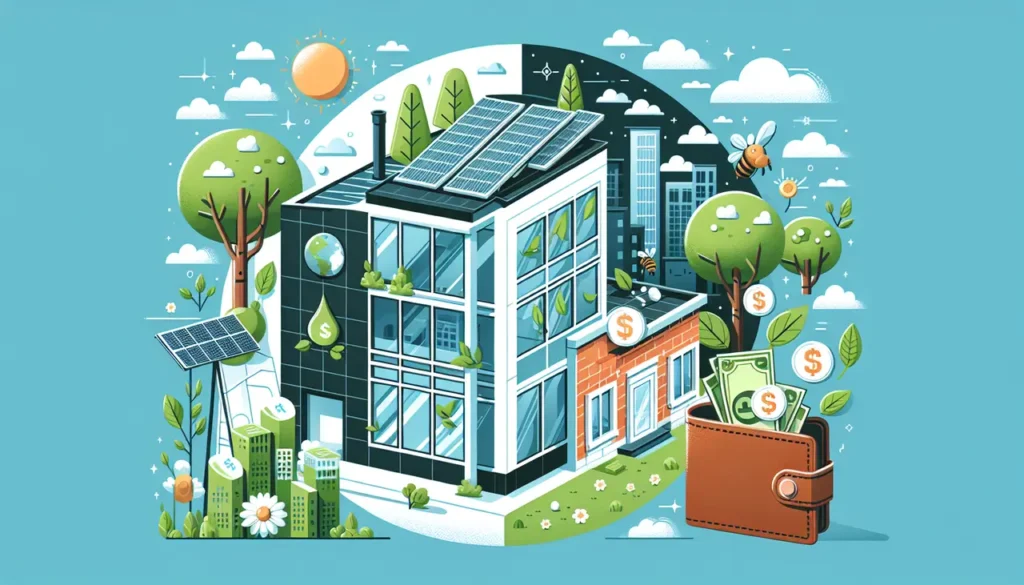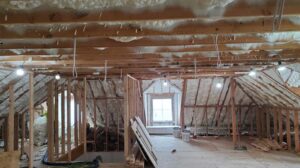So, you’re curious about commercial insulation? Smart move. Here’s the deal: Insulation in buildings is like a blanket for your office, store, or whatever commercial space you’re rocking. It keeps the heat in when it’s cold and out when it’s hot. But it’s not just about comfort. Proper insulation slashes energy use big time. Why? Because your heating and cooling systems don’t have to fight as hard to keep the place cozy. That means they use less energy, which is good for your wallet and even better for the planet.
Let’s get real—energy consumption is a hefty contributor to global emissions. By cutting down on the need for artificial heating or cooling, good insulation helps lower those emissions, battling climate change like a champ. That’s right; by insulating your commercial building, you’re basically helping save the world. Plus, let’s not forget the energy cost savings that’ll make your bank account smile. It’s a win-win. The better insulated your building, the less dough you’re throwing at utility bills. And with energy prices looking like a rollercoaster, that’s no joke. Bottom line: Commercial insulation is a game changer for both the environment and your bottom line.

The Role of Commercial Insulation in Reducing Carbon Emissions
Commercial insulation isn’t just padding for your building; it’s a climate warrior in a woolly disguise. Think of your business property like a thermos. A good one keeps your coffee hot without you having to blast a heater underneath it every hour, right? That’s what insulation does for your building. It traps the heat or the cool, depending on the weather, and levels out the temperature swings. By doing this, you’re not overworking your HVAC system – less energy to power it up, less carbon dioxide pumped into the atmosphere. It’s a win-win. Businesses everywhere are wising up to the fact that this isn’t just about saving the polar bears; it’s about saving green in your wallet too. Adding insulation to the roofs, walls, and floors of your commercial space means the HVAC system uses less energy. Less energy used equals less money spent on utility bills and less carbon emissions—insulation: the silent guardian of your budget and the planet.
Understanding the Different Types of Commercial Insulation Materials
When we talk commercial insulation, know this—materials matter. First up, fiberglass, the go-to for many. It’s got millions of tiny glass fibers and, yes, it traps heat like a champ. Affordable? You bet. Next, there’s cellulose, mainly recycled newsprint if you can believe it. Packed tightly, it blocks out the cold, but it’s a bit noisier to install. Now, for the eco-friendly crowd, we’ve got mineral wool. Rock or slag—take your pick—both fire-resistant and good for soundproofing too.
Don’t overlook rigid foam boards and spray foam, either. Foam boards stack up with the best for covering big spaces, easy to cut and fit. Spray foam, that’s the high-tech squirt-on stuff, expands to fill gaps, and yes, it seals air tight, top-notch for blocking moisture.
Choosing the right insulation isn’t rocket science, but it sure makes a difference. Each type has its own perks and quirks, from how green it is to how it fits the budget. So weigh your options, consider what your building needs, and don’t just go for the cheapest or the one you’ve always used. Matching the right type to your project—that’s key to trimming down those energy bills and that carbon footprint.
How Insulation Contributes to Energy Efficiency in Buildings
Insulation in commercial buildings is like wrapping up in a warm blanket on a cold night. It keeps the heat inside, so you rely less on your heating system to stay warm. Less energy used for heating or cooling means less fuel burned at power plants, which leads to fewer greenhouse gas emissions. In other words, good insulation reduces your building’s carbon footprint – the total amount of carbon dioxide and other carbon compounds emitted due to the consumption of fossil fuels.
Moreover, insulation is a smart way to save money. By maintaining a steady temperature, it’s easier for your HVAC system to do its job without overworking. Consequently, you’ll see lower utility bills, which is great for your budget. Effective insulation can cut the cost of heating and cooling by up to 40%.
To sum it up, proper insulation helps you:
- Slash energy bills
- Reduce reliance on HVAC systems
- Shrink carbon emissions
So, investing in quality insulation is not just about immediate gains; it’s a strategic move for financial savings and environmental sustainability over time.
The Economic Benefits of Investing in Commercial Insulation
Investing in commercial insulation doesn’t just pad your walls; it pads your wallet too. Here’s the deal: by boosting energy efficiency, insulation reduces heating and cooling costs. We’re talking big savings over time. Think about it – less energy to keep the building comfy means less money spent. And that’s not pocket change. The Department of Energy claims that proper insulation can slash heating and cooling costs by up to 30%. And let’s not forget about the green side of the coin. Reducing energy use means cutting down on those carbon emissions. It’s a twofer – saving dollars and the planet. It’s not just about upfront cash either. A well-insulated building has a better resale value. So, you’re not just saving now; you’re investing in the future value of the property. Sure, insulation costs might make you wince at first. But play the long game, and you’ll see it’s a smart move. You’re building efficiency into the bones of your business. And efficiency is just another word for profit.
Case Studies: Companies That Saved Money Through Insulation
Several businesses have slashed their energy bills and shrunken their carbon footprint by investing in proper insulation. Take, for instance, a manufacturing company in Michigan – they retrofitted their factory with new, high-efficiency insulation and saw a 20% reduction in their heating costs. That equates to thousands of dollars saved annually, which can be reinvested into the business. Another example is a grocery store chain that implemented insulation systems across all refrigeration units. The result was a staggering 30% drop in energy usage, not to mention the positive impact on the environment. These case studies highlight that insulation isn’t just good for the planet; it’s also great for the bottom line.
Rebates and Incentives for Commercial Insulation Projects
Government programs and energy companies often offer rebates and incentives to encourage businesses to invest in energy efficiency, including commercial insulation projects. It pays to research what’s available in your area, as these programs can significantly reduce the upfront cost and improve the return on investment. Discounts, tax incentives or direct rebates can slash the expense, making it more affordable to insulate your commercial property. This can lead to substantial energy savings, trimming your utility bills and shrinking your carbon footprint. Check with local utility companies and look up government sites for energy-efficient improvements to see what rebates or incentives you might be eligible for.
Assessing Your Building’s Insulation Needs and Opportunities
Before initiating the insulation process for your commercial building, pause to assess the situation comprehensively, highlighting the importance of understanding the benefits of commercial insulation. Identify the areas where heat loss or unwanted air infiltration occurs, such as through walls, roofs, floors, and particularly through windows and doors, which are infamous for their role in energy inefficiency. Addressing these vulnerabilities by upgrading insulation can significantly enhance energy conservation, directly impacting your utility expenses in a positive manner.
Furthermore, evaluate the performance of your heating and cooling systems. Inefficient insulation forces these systems to overextend, resulting in unnecessary expenditure and increased carbon emissions. Proactively addressing insulation concerns allows for a reduction in energy consumption, earning appreciation from environmental perspectives for contributing to carbon footprint reduction.
A crucial piece of advice is to avoid making assumptions about your building’s insulation needs. Engaging a professional to conduct a detailed energy audit can uncover hidden inefficiencies, offering a clear blueprint for where to focus insulation improvements. Armed with this information, you can strategically invest in insulation upgrades that promise the most substantial benefits in terms of energy savings and enhanced comfort levels within your building. This approach not only optimizes your investment but also aligns with environmental sustainability goals, showcasing the multifaceted benefits of commercial insulation.
Installation Tips for Maximizing Insulation Effectiveness
Getting commercial insulation right is like fitting the pieces of a puzzle perfectly – do it well, and you’ll reap the benefits in energy savings and reduced carbon emissions. Here are some installation tips that can make all the difference. Make sure the building is properly sealed; gaps and cracks can undermine insulation efforts. Choose the right kind of insulation for your needs – materials like fiberglass, cellulose, and foam all have their pros and cons. Installing insulation with the correct R-value, which measures resistance to heat flow, is crucial for effectiveness. It’s often tempting to go DIY, but hiring a professional ensures a snug fit and no missed spots, which could let the cold creep in. Lastly, don’t forget about maintenance. Insulation can settle over time, so check it now and then to make sure it’s still doing its job. Do it right, and you’ll see the difference in your bills and your carbon footprint.
Conclusion: Balancing Cost-Savings with Environmental Responsibility
In wrapping up, it’s evident that exploring the benefits of commercial insulation presents a compelling case for both financial savings and environmental stewardship. The initial investment might give pause, yet considering the broader perspective reveals its true value. By opting for high-quality insulation, businesses can significantly reduce their energy consumption, leading to fewer carbon emissions and substantial reductions in energy expenses. This dual advantage serves as a testament to the role of commercial insulation in promoting eco-friendliness alongside economic efficiency. Every step taken towards climate change mitigation counts, and insulating your commercial premises stands out as a strategic move with guaranteed returns. Rest assured, such an investment not only favors your financial bottom line but also contributes positively to planetary health. Embracing green practices transcends trendiness, embodying a commitment to our collective future. Thus, in the quest for sustainability, the benefits of commercial insulation allow organizations to navigate the balance between cost-saving and environmental responsibility with assurance and foresight.





